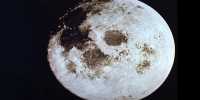Although the Moon’s so-called oceans are dry, frozen lakes may exist on our satellite, which might offer vital water for personnel on any future lunar outposts. Although lunar volcanoes haven’t erupted in over a billion years, experts believe they have left us with a valuable legacy that might make creating bases on the Moon lot more feasible. If the researchers are correct, certain craters may hold thick sheets of ice that may spare long-term Moon missions the enormous expenses of importing water from Earth or extracting it from less concentrated deposits.
The Planetary Science Journal makes the argument for lunar ice deposits having volcanic origins. Rather than actual observations, it is based on models of lunar volcanism and situations since then. The old Moon, like the Earth’s mantle, would have contained water in its interior, according to Colorado University Boulder graduate student Andrew Wilcoski and co-authors. During eruptions, volcanoes would have blasted forth this water, as well as a lot of ash, lava, and other gases. A thin, transitory atmosphere of water vapor and carbon monoxide would have resulted. Some of this water would have landed on the Moon’s surface and turned to ice if it was out of direct sunlight.
In a statement, Wilcoski stated, “We picture it as a frost on the Moon that has built up over time.” Near the border between the day and night sides, the Moon’s poles may have glinted silver for a moment. Where the Sun is high in the sky, the ice would have long since turned to gas and vanished. It would have a far higher chance of surviving towards the poles, in the bottom of craters that haven’t seen sunlight since their formation. Because the Moon’s orbital plane is not nearly as slanted as the Earth’s, it lacks pronounced seasons.
Water ice occurs near the lunar poles, as evidenced by meteorites and the Lunar Reconnaissance Orbiter, but “its origin, amount, and distribution are not well understood,” according to the report. It’s widely assumed that it was delivered by comets hitting the Moon or the solar wind, in which case modest quantities near the surface may have been provided. The work of Wilcoski and his colleagues is more upbeat. According to the report, 40 percent of the water vapor generated by lunar volcanoes between 4 and 2 billion years ago froze at the poles, with ice hundreds of meters thick in certain areas — enough to keep a lunar colony stocked for a long period.
“It’s feasible that there are large sheets of ice 5 or 10 meters beneath the surface,” stated co-author Dr. Paul Hayne. If the authors are correct, the ice deposits are asymmetric, with the South Pole possessing about double the ice mass of the north. Based on a combination of depth and closeness to the pole, the lunar South Pole has greater and colder “cold traps” in which the ice might build.
Following recent proof that plants may grow on lunar soil if given water, albeit with difficulty, the possibilities for a long-term lunar base appear promising. The authors believe that the atmosphere formed by huge eruptions may have persisted for thousands of years before settling or fleeing to space, which is a fascinating feature of the investigation. However, the carbon monoxide would have made it dangerous to any visitors with human-like biology, and with an average of 22,000 years between eruptions, the Moon would have been more as it is now for most of the period.
















